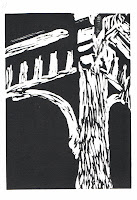Psycho scared the poop out of my when I was a kid. I was totally into the whole movie, and good to go, no worries with the whole shower scene and murder...but when Norman Bated had that internal monologue in the epilogue of the movie, where he's his mother...and then I realized that all those conversations in the movie he had with his mother were really just him...my poor 10-year-old brain couldn't quiet handle it. But I KNEW I was fascinated by it.
Anyhow, there's no scene to quite capture that weirdness like this one, when Norman realized that his "mother" has killed Marion. I took that picture and cranked up the contrast:
Then added a little photoshop static for fun.
And then silkscreened it with a touch of blood-red for some psychological effect.
Love, love, love.
Which brings me to a fine point I have been debating...the issue of copyright. I have trouble finding information about the current copyright of Hitchcock's films (I think they were re-issued to someone in 1997), but I don't know if that counts for things like screenshots from the films. And if you change the screenshots by altering them and adding awesomeness (see above), can you skirt around copyright issues? My guess is no, but there's no good guide out there for these things. I really want to do some art based on old movies or characters...but I have a hunch it's illegal. Anyone out there with any information about this?
In the meantime, I shall love Norman.











































